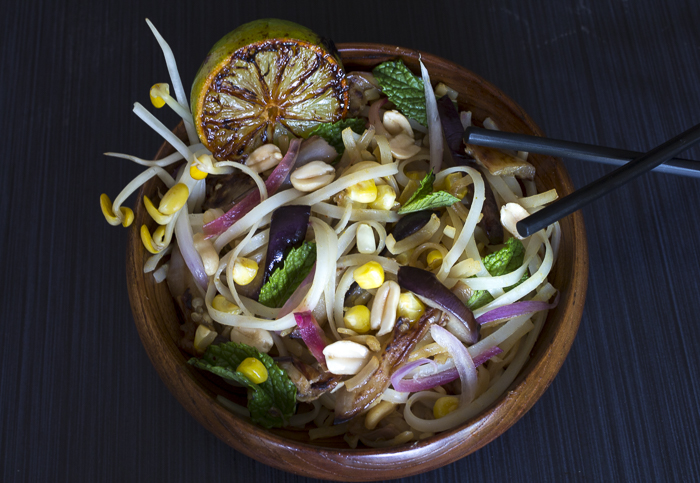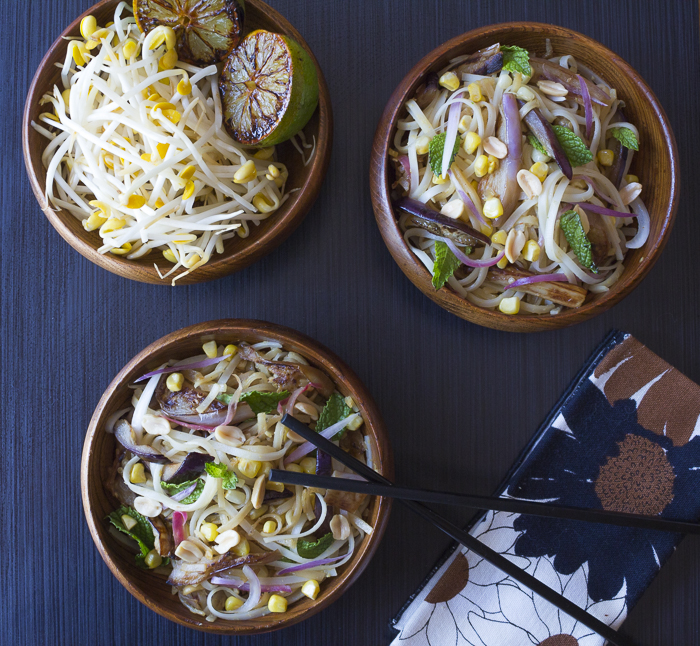I’m loving a home made Pad Thai with loads of local summer veggies! Toss in fresh mint, peanuts and bean sprouts for a fresh crunch


Pad Thai are stir-fried rice noodles “Thai-style.” A great one-pot wok dish – a seasoned cast iron skillet will work well too for the home chef. Making this at home is a satisfying event as you choose the add-inns and explore the classic technique.
For Thais, the explanation lies in Pad Thai’s balance of flavors and textures—the three primary Thai flavors of salty, sour, and sweet, and a fourth, spicy, added to taste in the form of chilies. The bean sprouts and peanuts add a desirable, though subtle, crunch, a foil for the soft rice noodles and an abundance of vegetables. A successful Thai cook keeps this balance in mind when composing a recipe or a full menu of complementary flavors and textures.
In summertime I am constantly visiting farmers’ markets and adore the endless piles of home-grown eggplant in all their purple hues and interesting natural shapes. I think their flavor and texture is perfect in many asian noodle dishes, and a delicious complement with thai ingredients. Corn adds a pop of color and some extra crunch with the peanuts and cool, crisp bean sprouts. A generous toss-in of mint leaves freshens and elevates the flavor.
Tamarind (leathery pods that resemble beans) is a must ingredient in Pad Thai – provides many ethnic dishes with a distinctively fruity tang. It is available at Asian markets in two common forms. Tamarind Pulp and Tamarind Paste. The pulp is sold with seeds in block form, and the seeds need to be stained out. The paste is sold in looser blocks, with the seeds taken out. Save a step and source out the paste (it has no additives.)
The tangy fruit is used like lemon juice, lime juice or vinegar to add a refreshingly acidic accent to foods and sauces.
$2.49 for 400 grams of tamarind is a bargain – it’s about 14 ounces, find in asian shops and some gourmet and health food stores.
My recipe starts with cooking the vegetables in roasted peanut oil, then the other ingredients are stirred in. Rice noodles are simply soaked (not boiled – they will cook further in the wok.) I use my “master pad thai blender sauce” for ease, just pour into the veggies and noodles and the flavors of Thailand all come alive. Make this ahead of time and you can be a Pad Thai chef in no time!
“Palm Sugar“ is traditionally used in thai cuisine. Since it is hard to find, I use coconut palm sugar. The difference:
Coconut Palm Sugar” is made from the coconut palm tree, the same tree that grows coconuts. Just plain “palm sugar” may be made from the same coconut tree, or it may be made from one of two other varieties of palm trees which also produce a sweet nectar.
Classic Pad Thai is not too wet, or not too dry. Excess gloppy sauces are decidedly unwelcome.
Other add ins to consider: eggs (scrambled in the wok), shrimp, chicken and tofu.
Enjoy this timeless recipe,
Karen






I love the idea of this dish.. Your blog is beautiful.. Paula handler
Thank you Paula for your support! Happy Thanksgiving to you. Fondly, Karen